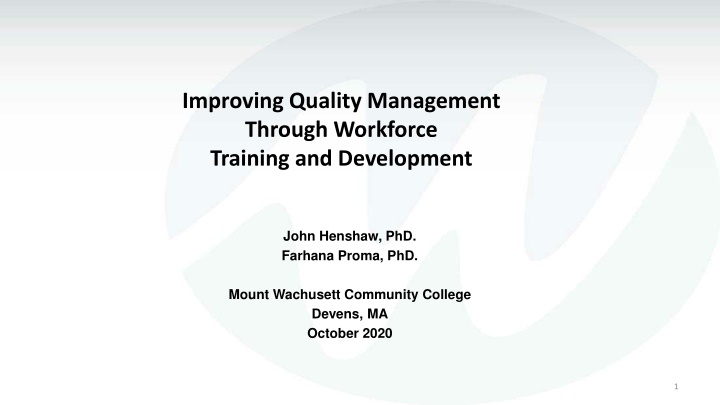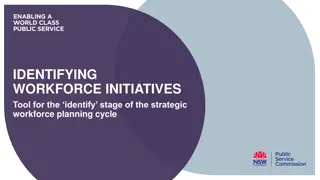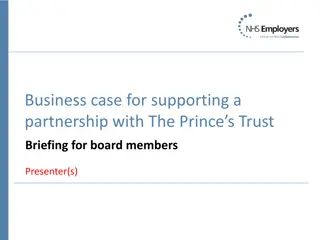Enhancing Quality Management Through Workforce Training and Development
This study explores the significance of quality management systems in helping organizations meet customer expectations and regulatory standards. It emphasizes the importance of workforce training and development in continuous improvement processes, starting from identifying local needs, engaging employers, and adapting to economic conditions. Challenges such as funding, curriculum development, training logistics, and job placement are also addressed to ensure effective quality programs.
Uploaded on Oct 06, 2024 | 1 Views
Download Presentation

Please find below an Image/Link to download the presentation.
The content on the website is provided AS IS for your information and personal use only. It may not be sold, licensed, or shared on other websites without obtaining consent from the author.If you encounter any issues during the download, it is possible that the publisher has removed the file from their server.
You are allowed to download the files provided on this website for personal or commercial use, subject to the condition that they are used lawfully. All files are the property of their respective owners.
The content on the website is provided AS IS for your information and personal use only. It may not be sold, licensed, or shared on other websites without obtaining consent from the author.
E N D
Presentation Transcript
Improving Quality Management Through Workforce Training and Development John Henshaw, PhD. Farhana Proma, PhD. Mount Wachusett Community College Devens, MA October 2020 1
Quality Management Systems: Help an industry or organization that provides a product and/or service meet customer/ regulatory expectations. Require training of employees at all levels of an organization. Are Continuous Improvement Processes. 2
Developing Quality Programs begins with identifying local need and partners. Survey of need in terms of skill levels and content, etc. Employer Engagement to determine job opportunities and workforce training needs. Partners include: Workforce System Chambers of Commerce Direct Employer relationships Industry Advisory Boards Work-based experience Interviewing/ hiring participants 3
Its the economy, Local economic conditions impact the scope of training to be provided. This is influenced both by the available potential workforce and employer demand. Quality Training can be a component of an entry level or middle skills training program, or as a stand alone program focused on specific Quality roles in an organization. 4
Examples: Great Recession High unemployment rate with many skilled workers seeking career change. Career changers needed broad program to address new career pathways. Training: Biomanufacturing Workforce Training Program Economic Recovery Low unemployment rate focused opportunity for incumbent worker upskilling. High underemployment rate due to workers with multiple jobs. Training: Quality modules within entry level program. Stand alone Quality Training for middle skills. 5
PROGRAM CHALLENGES Funding: Curriculum development Training and Certification Costs Support Costs Grant funding (federal and state) has been critical for the development, implementation and sustainability of programming. Identifying Participants: Recruitment / Assessment Employment status High School / Adult Education Comprehensive approach attempts to develop pathways for participants of all levels. 6
PROGRAM CHALLENGES Training Logistics: Scheduling challenges Instructor availability Flexibility in scheduling is the key (time, format, location) Job Placement: Employer/ Workforce System partnerships Work-Based-Learning Opportunities Internships / Job Shadowing Registered apprenticeships Regular communication with employers is essential. 7
WORKFORCE DEVELOPMENT PROGRAMS AT MWCC Quality Training as part of comprehensive programs include: Biomanufacturing Workforce Training Program (DOL) Quality Training as part of 220-hour program co-developed with Bristol Myers Squibb. Industry Readiness Training: Advanced Manufacturing Training (DOL) Entry-level Job Training Created as 15 20 hours of 160 hour program. Led to development of stand-alone higher level training (Quality Systems Training). 8
STAND-ALONE QUALITY TRAINING Guided by American Society for Quality certifications as Industry- Recognized Standard. MWCC coordinated ASQ examination on site following program and review. Quality Systems Training: 40- hour training geared towards Certified Quality Process Associate. Quality Technician Training: 100 to 140-hour training programs geared to support appropriate certification based on prior knowledge and experience. Quality Yellow Belt Training: Focus of DOL-funded TechHire program aimed at young adults (17-29). Enabled students to seek Green Belt if prior experience suitable. 9
CORPORATE TRAINING IN QUALITY OEM Biomedical Device Manufacturer (Injection Molded Plastics): Quality Department Staff from 2 shifts met mid-day (4-hours/ week) for 10 weeks. Most had little formal Quality Training Empowered employees to fulfill Quality Mission. Incorporated company-specific documentation through Non-Disclosure Agreement. Several staff sought further training/ advancement Biomedical Equipment Manufacturer (Diagnostics): Selected candidates from 2 plants for Registered Apprenticeship Training (150 hours Related Technical Instruction). Program challenges included spreading out training over several months. Hiring managers highlighted job performance improvements; employees and HR indicated frustration over pass rate of about 50%. Needed to better manage expectations. 10
CORPORATE TRAINING IN QUALITY Biomedical Equipment Manufacturer (Filtration Systems): Quality Department Staff from multiple areas and shifts participated. Most had received Quality Training, some to higher levels. Extensive review of company documents and processes for incorporation into training. Coordinated 15-week program, 2 afternoons per week to reach 120 hours. Mid-March (75% complete) needed to pivot due to COVID-19 restrictions. Completed program on-line and facilitated certification exam using ASQ-certified employees to proctor exam on site (no external visitors allowed). Workforce Training Fund Programs: Commonwealth of Massachusetts funding for employers to receive 50% cost share for training based on corporate needs analysis. 11
RECENT COMPANIES WITH LEAN OR QUALITY TRAINING Spectro Coating (manufacturing): Lean, ISO 9001, Auditing Main Street Bank (financial): Lean Biotechne (medical manufacturing): Lean, ISO 13485, Quality Van Pool (transportation): Lean Fosta Tek (manufacturing): ISO 9001, Auditing, QMS DS Smith (manufacturing): Lean, Kaizen Catania Spagna Oils (food manufacturing): Lean
OVERVIEW OF QUALITY CONTENT Farhana Proma, PhD. 13
QUALITY TRAINING at MWCC Workforce Development QUALITY TRAINING at MWCC Workforce Development We provide recognized six sigma fundamentals training with the aim to - Prepare individuals for ASQ green belt/ yellow belt tests - Prepare employees for supporting quality issues in industry - Impart six sigma and quality fundamentals to employees so that they can deliver tasks guided by quality experts - Make adult learners acquainted with quality and continuous improvement concepts, enhancing their industry-readiness - Provide knowledge base for employees on industry- specific topics, as needed 14
MWCC WORKFORCE DEVELOPMENT Quality Yellow Belt Training Quality Green Belt Training Quality Basics Intro level Industry Readiness Training Custom Quality Training based on specific industry needs 15
QUALITY YELLOW/GREEN BELT TRAINING Training with the aim to pass the yellow/ green belt exam of American Society for Quality (ASQ) Highly sought-after credentials in manufacturing/ biotech industries Training is delivered in four modules based on the body of knowledge suggested by ASQ ASQ suggests at least 80 hours study for yellow belts MWCC provides 120 hours of trainer- assisted content, including study materials, exercises and practice tests Content and training for Green Belts are more in-depth and technical 16
QUALITY - Certifications https://asq.org/cert/faq/career-track 17
QUALITY YELLOW/GREEN BELT TRAINING Content for quality is organized in four modules. Module 1 introduces the concepts of quality, customer, supplier, and quality management principles Module 2 introduces the six sigma methodology, and fundamentals of measurement and analysis Module 3 is more math based. It revisits mathematical concepts and basic statistics to build on statistical process control methodologies Module 4 introduces Lean concepts and process validation DMAIC Methodology 18
QUALITY GREEN/YELLOW BELT MODULES A continuous flow on DMAIC methodology is created Definition and History of quality Six Sigma structure Shop Math review Lean concepts Define Project selection Introduction to Statistics Root Cause Analysis in Improve phase Definition of process Root Cause Analysis in Define phase Descriptive Statistics Customer Vs Supplier Validation Hypothesis testing Cost of poor quality Project planning Change control Graphical analysis Module 2 Module 3 Module 1 ISO 9000 Teamwork Module 4 Statistical Process Control Non-Conformation Voice of customer Process Capability Analysis CAPA system Specifications Introduction to metrology Measurement fundamentals Data collection Measurement fundamentals 19
QUALITY BASICS/ WHITE BELT The quality basics training content includes but is not limited to o Continuous Improvement concepts and philosophies o Concepts related to Descriptive Statistics and Key Performance Indicators (KPIs) o Seven tools of Quality o Lean concepts and tools PLAN ACT DO CHECK (STUDY)
TRANSITION TO ONLINE LEARNING MWCC successfully transitioned to online quality yellow belt training after Covid. All content was transformed into self-paced learning material on Blackboard online learning platform Learning material was combined with instructor-led learning and assistance one two times in a week Lectures (voice over PowerPoint), exercises, homework assignments, and practice tests were uploaded and paced by instructor 21
TRANSITION TO ONLINE LEARNING SUCCESS AND CHALLENGES Success Time flexibility Availability of all materials electronically Access to online content any time via Blackboard Exam preparation done systematically Review of learned concepts on request Challenges Progress tracking Class / group discussions Team tasks Online and paper material coordination Technologically challenging Limited live interaction/ question-answer
TALE OF TWO TRAINEES Katrina (pseudo name) was in one of our yellow belt cohorts. When she started, she was unemployed. She highlighted the class in her resume, and successfully obtained employment as a quality assurance specialist at a medical device manufacturing company. She got the job on week 2, but still completed the full 6-week course, and passed the Yellow Belt exam. Her company was more than excited to assist her with flexible schedule and encouragement. 23
TALE OF TWO TRAINEES Jennifer (pseudo name) was in our latest cohort. She learned about six sigma project charter in class and used it the next day at her job. She received heavy accolades from her manager, and the company encouraged and funded her to get a six sigma green belt certification. 24
THANK YOU 25























